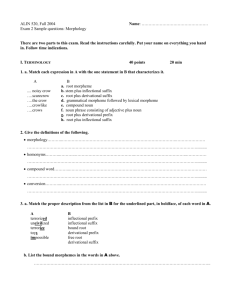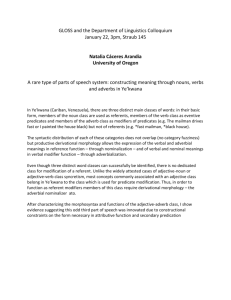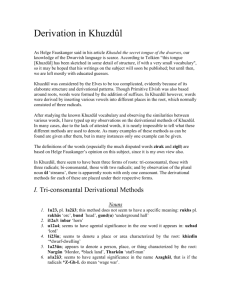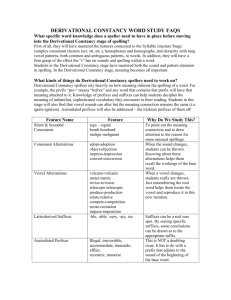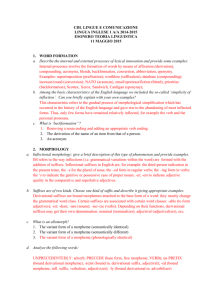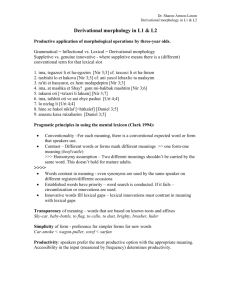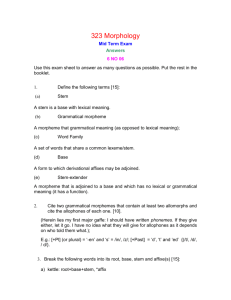The Derivational Structure of Words
advertisement
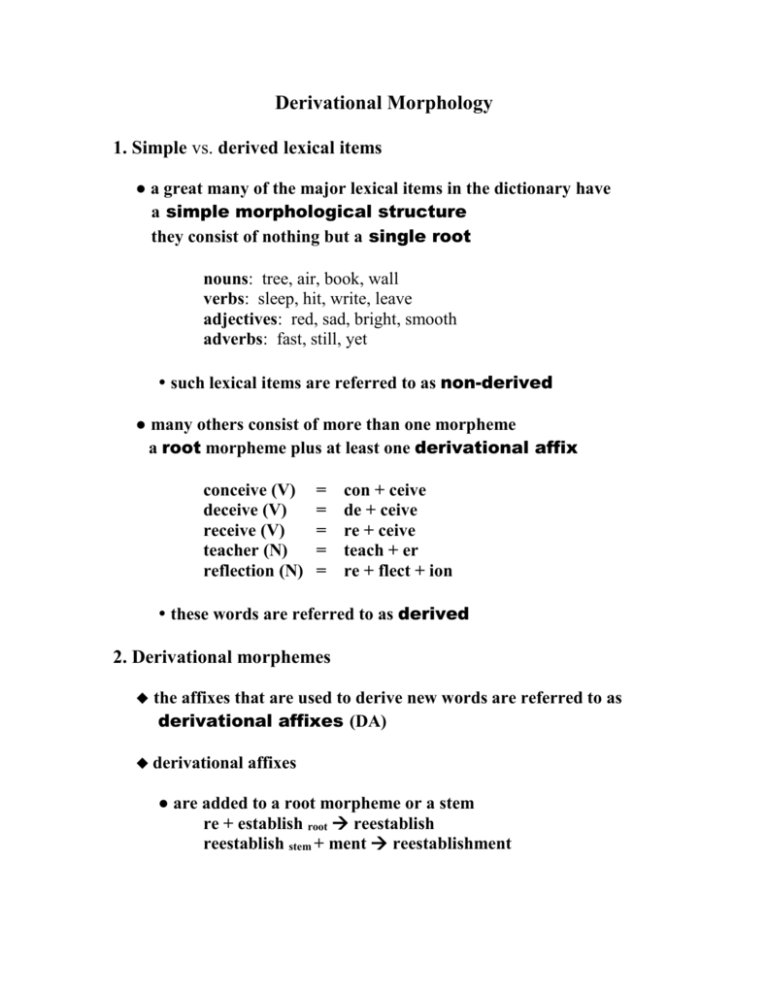
Derivational Morphology 1. Simple vs. derived lexical items ● a great many of the major lexical items in the dictionary have a simple morphological structure they consist of nothing but a single root nouns: tree, air, book, wall verbs: sleep, hit, write, leave adjectives: red, sad, bright, smooth adverbs: fast, still, yet such lexical items are referred to as non-derived ● many others consist of more than one morpheme a root morpheme plus at least one derivational affix conceive (V) deceive (V) receive (V) teacher (N) reflection (N) = = = = = con + ceive de + ceive re + ceive teach + er re + flect + ion these words are referred to as derived 2. Derivational morphemes the affixes that are used to derive new words are referred to as derivational affixes (DA) derivational affixes ● are added to a root morpheme or a stem re + establish root reestablish reestablish stem + ment reestablishment ● derive a new word with a new meaning consist consistent write writer ● can change the grammatical category of the word to which they are added VERB + ER NOUN: write writer NOUN + EN VERB: fright frighten NOUN + FUL ADJECTIVE: care careful ADJECTIVE + LY ADVERB: careful carefully ADJECTIVE + EN VERB: sweet sweeten ● derivational morphemes can be added to the beginning or end of a word derivational prefixes: re+assess reassess derivational suffixes: re+write+ment reassessment 3. Derivational processes ● processes of derivation that transform a word into another word that has a related meaning VERB + ER NOUN: write writer 4. Derivational rules ● not every word belonging to a grammatical category can undergo a given derivational process VERB + ER NOUN: *establish + er *establisher ● derivational rules specify how derivational affixes are applied to roots and to stems to generate the lexical items in the dictionary VERB + ER NOUN: write writer MIS + VERB VERB: mis + spell misspell UN + ADJECTIVE ADJECTIVE: un + happy unhappy 5. Productivity of derivational rules and derivational processes ● derivational rules and processes and the affixes they use fall into two categories with respect to their productivity productive patterns may be applied to form new lexical items as the need arises - the derivational prefix re- is found in many existing verbs rearm, rerun, return, rehire, resend given a new verb skrell, we might form re-skrell = 'skrell again' non-productive patterns (1) are unlikely to give rise to new formations (2) may be entirely opaque (= not apparent to native speakers) (3) apply to limited numbers of forms - deceive, receive, conceive, perceive: it is unlikely that any new verbs with -ceive will appear - unhappy: while the productive prefix un- is obvious (unmet, unphased), the segmentation of happy into hap (cf. mishap) and -y may not be at all obvious 6. Recursion ● derivational rules can be applied more than once to a stem to produce new lexical items 1. fiend noun 2. fiend + ish fiendish adjective 3. fiendish + ness fiendishness noun if we adopt the convention of enclosing lexical items in parentheses, then we can represent these facts in the following way: N ( fiend ) Adj ( ( fiend ) + -ish ) N ( ( ( fiend ) + -ish ) -ness ) the lexical item fiendish is embedded in the lexical item fiendishness, and that the lexical item fiend is embedded in the lexical item fiendish in the production of the lexical item fiendishness, the rules of derivational morphology have applied more than once: - first to produce fiendish, and - then again to produce fiendishness ● in this sense, derivational rules are recursive: they may reapply to their output to produce new lexical items. ● each successive recursive application of derivational rules gives rise to lexical items with increasingly complex constituent structure 7. Derivational morphology: Overview The derivational sub-module of morphology consists of an inventory of roots an inventory of derivational affixes the rules for applying derivational affixes to roots and stems the lexicon, or dictionary, itself

